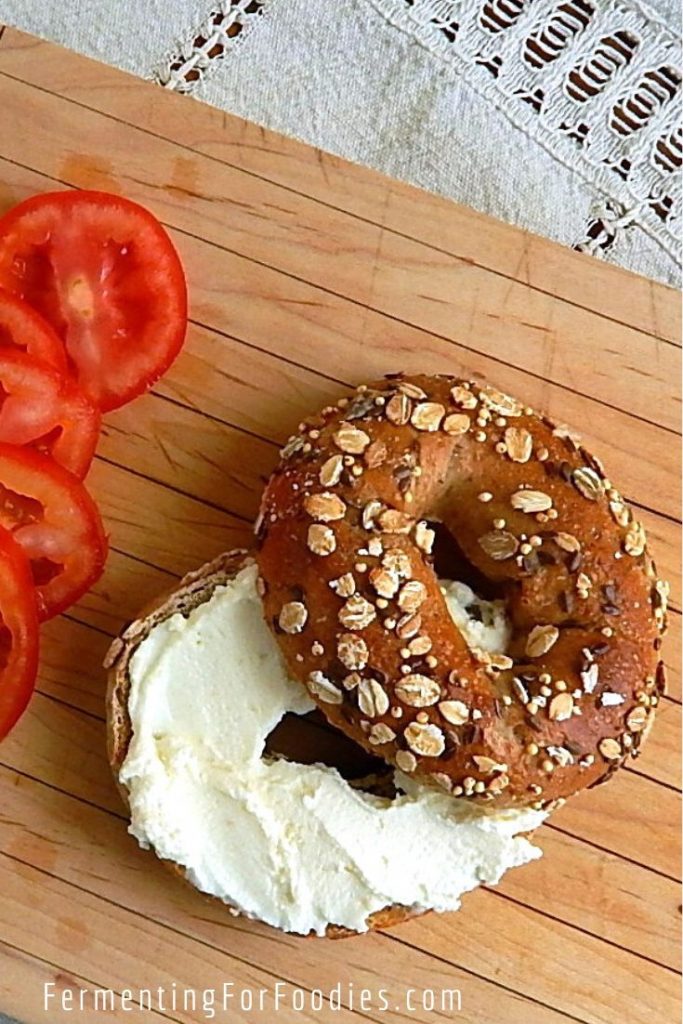How to Make Cream Cheese Without Mesophilic Culture

There are so many different ways to make homemade cream cheese. Milk can be curded and set with yogurt or lemon juice. However, setting the curd with rennet is the best way to get really thick cream cheese.
Homemade cream cheese is one of the easiest cheeses you can make. Here are a few reasons why I love making cream cheese.
- It's affordable! It is about half the cost of store-bought bricks of cheese, and much cheaper than fancy homestyle cream cheese.
- The flavour is amazing. I recommend French-style cream cheese and preculturing for the richest flavour, however, simple rennet-set cream cheese is sweet, creamy and delicious.
- A really simple recipe. Since it is a fresh cheese, it doesn't require as much precision around sterilization and heating. And there's no need to cut the curd or press the cheese. It's a really easy recipe.
French-Style Cream Cheese
This recipe has two options: making a simple set curd cream cheese with rennet or making a French-style cheese by adding a bit of culture.
The recipe is the same either way, however, if you want the added flavour of cultured cream cheese, then you need to add a little starter culture with the rennet.
Homemade cream cheese is set at 72F, so you will need to add a mesophilic culture. Here are three different options that you can simply add with the rennet:
- Mesophilic cheese culture: Use 1 packet, enough for 2 gallons of milk.
- Milk kefir: Add a 1/4 cup of kefir cultured milk (not the grains).
- Cultured buttermilk: Add 1/4 cup of cultured buttermilk. Just be sure to use buttermilk that has a good quality culture. The culture is usually better from organic or small dairies than with massed produced buttermilk.

Flavoured Cream Cheese
Who doesn't love flavoured cream cheese? It's a delicious way to spruce up a bagel, serve in a sandwich or spread on crackers.
Homemade cream cheese is soft, creamy and spreadable. Which makes it perfect for mixing in additional flavours. Here are a few popular options. Each of these flavours are designed to be mixed into 1 batch of cream cheese (approximately 4 cups).
- Berry Whipped Cheese: Mix 1/2 cup of finely chopped fresh berries into a batch of cream cheese. Blueberries, raspberries and strawberries are ideal.
- Cinnamon Honey: Mix in 2 tsp cinnamon, a dash of nutmeg, 1/2 tsp vanilla and 1/2 cup of honey. Perfect as a dip for apples or spreading on carrot cake.
- Roasted Garlic and Red Pepper: Oven roast 2 red peppers and 4 cloves of garlic. Peel and deseed the red pepper. Grind the red pepper and garlic into the cream cheese using a food processor.
- Herbs: Finely dice 1/2 cup of fresh basil, 1/2 cup of chives and 2 tbsp of fresh parsley and stir into the cream cheese.
- Boursin-style: Follow this recipe to make your own Boursin-style cheese.
Homemade Cream Cheese

Cream cheese is so simple that it's perfect for beginners. Try making a French-style cultured cream cheese or flavour it with berries, herbs or garlic. See the sections above for more information.
- Prep Time: 15 minutes
- Total Time: 35 minutes
- Yield: 4 cups 1x
- Category: Cheese
- Method: Cultured
- Cuisine: French
- Diet: Vegetarian
- 4 cups milk (any percentage)
- 4 cups heavy cream
- 2 drops calcium chloride (mixed with 2 tbsp chlorine free water)
- 3 drops of liquid rennet (or 1/4 tablet mixed with 2 tbsp of chlorine free water)
- 1 tsp non-iodized salt (preferably cheese salt)
- Heat milk and cream up to 72 F.
- Gently whisk in calcium chloride for 1 minute. Then mix in the rennet, being sure to use an up and down motion so that it is fully mixed in. If you want to make a cultured French-style cream cheese, add the mesophilic culture with the rennet. See the section above for more details.
- Leave the pot of milk to set for 24 hours. It needs to be maintained at roughly 72 F. See the notes for different ways of maintaining the temperature.
- After 24 hours the milk will have firmly cured. Without cutting the curds, pour the entire pot of curded milk into a strainer lined with several layers of cheesecloth. Tie the corners together and hang the curd to drain for 6-8 hours.
- Remove curds from the cheesecloth and place in a bowl with the salt. Stir with a spoon to combine. Add any additional flavours (see section above) at this point. The cream cheese will be quite soft, however, it will firm up after being refrigerated.
- Homemade cream cheese tastes best if used within 2 weeks.
Notes
- If you have never made cheese before, you can find more information about each of the steps here.
- I use a folding fermentation box for all of my ferments, however an exact temperature is not required. You can keep your curding milk warm by putting it near your hot water heater or on top of your fridge.
- See the section above for details on how to make French-style cultured (and probiotic!) cream cheese.
Keywords: probiotic, easy, flavours, berries, roasted garlic, cinnamon, herb, keto, Boursin, traditional, fermented
Reader Interactions
How to Make Cream Cheese Without Mesophilic Culture
Source: https://www.fermentingforfoodies.com/homemade-cream-cheese/